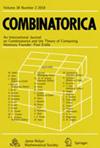关于巴洛格、塞梅雷迪和高尔斯定理的说明
IF 1
2区 数学
Q1 MATHEMATICS
引用次数: 0
摘要
我们证明,每个具有能量 \(E(A)\ge |A|^3/K\) 的可加集 A 都有一个大小为 \(|A'|ge (1-\varepsilon )K^{-1/2}|A|\) 的子集 \(A'\subseteq A\) ,使得 \(|A'-A'|\le O_\varepsilon (K^{4}|A'|)\).从本质上讲,这是巴洛格-塞梅雷迪-高尔定理中可以得到的最大结构集。本文章由计算机程序翻译,如有差异,请以英文原文为准。
Note on the Theorem of Balog, Szemerédi, and Gowers
We prove that every additive set A with energy \(E(A)\ge |A|^3/K\) has a subset \(A'\subseteq A\) of size \(|A'|\ge (1-\varepsilon )K^{-1/2}|A|\) such that \(|A'-A'|\le O_\varepsilon (K^{4}|A'|)\). This is, essentially, the largest structured set one can get in the Balog–Szemerédi–Gowers theorem.
求助全文
通过发布文献求助,成功后即可免费获取论文全文。
去求助
来源期刊

Combinatorica
数学-数学
CiteScore
1.90
自引率
0.00%
发文量
45
审稿时长
>12 weeks
期刊介绍:
COMBINATORICA publishes research papers in English in a variety of areas of combinatorics and the theory of computing, with particular emphasis on general techniques and unifying principles. Typical but not exclusive topics covered by COMBINATORICA are
- Combinatorial structures (graphs, hypergraphs, matroids, designs, permutation groups).
- Combinatorial optimization.
- Combinatorial aspects of geometry and number theory.
- Algorithms in combinatorics and related fields.
- Computational complexity theory.
- Randomization and explicit construction in combinatorics and algorithms.
 求助内容:
求助内容: 应助结果提醒方式:
应助结果提醒方式:


